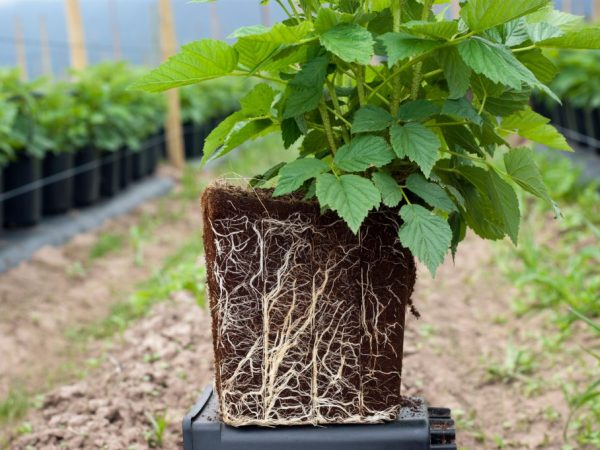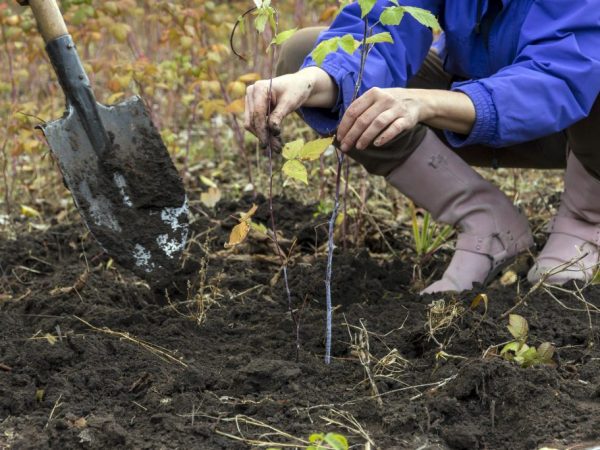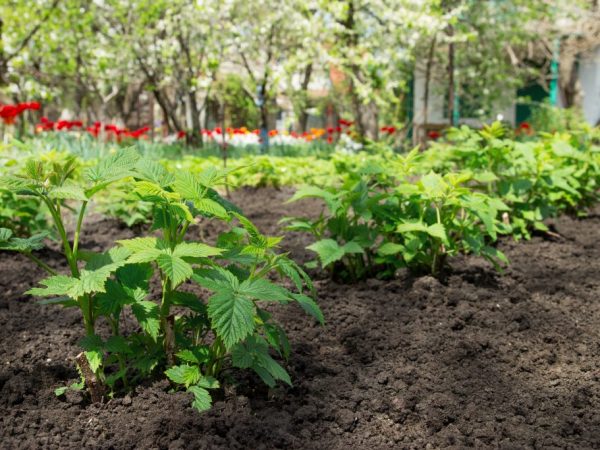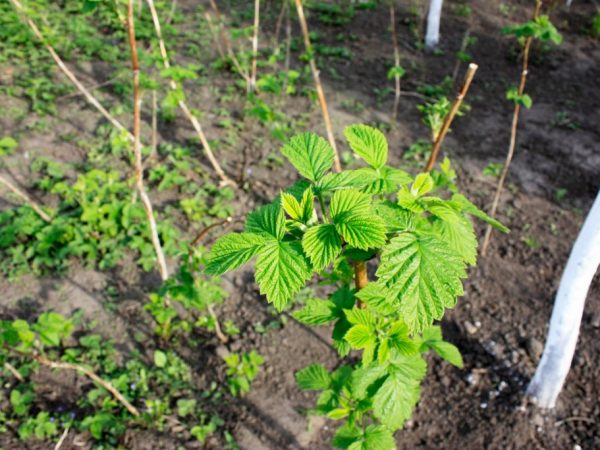Basic rules for autumn planting of raspberries - step by step instructions
Raspberries are one of the most beloved horticultural crops. It is planted both in spring and summer, but planting is most convenient in autumn. From September to mid-October, the weather conditions are moderately warm and humid - they are optimal for the regeneration of seedlings.
- Conditions for the procedure
- Suitable dates
- Lunar calendar
- In different regions
- Advantages and disadvantages of autumn planting
- Selection of seedlings and their preparation
- Organization of the place
- Recommendations
- Algorithm of preparation
- Planting methods
- Bush
- Tape
- Trench
- Follow-up care
- When will it begin to bear fruit
- Common mistakes gardeners make

Basic rules for autumn planting of raspberries - step by step instructions
Conditions for the procedure
The autumn planting of raspberries has a good effect on its further development. The main thing is to carry out the procedure before the cold weather, so that the root system of the seedlings has time to recover, acquire new roots instead of the truncated ones.
During this period, a culture is planted if:
- A winter-hardy variety has been selected. A cold-sensitive variety is best planted in spring.
- The weather conditions are favorable. The autumn procedure is most common in the south and in areas with a temperate climate.
- You need to get the harvest faster. The bush will bear fruit in the next growing season. And the fruiting of raspberries planted in spring occurs only after a year.
Suitable dates
The timing is determined by climatic features in the growing area. The main nuance is that the seedling should have time for full rooting (at least 3 weeks).
Lunar calendar
Many owners of private plots, performing work in the garden and vegetable garden, are guided by the Lunar calendar.
It is believed that on certain days a celestial satellite has a positive or negative effect on the development of plant organisms, which affects the effectiveness of garden activities.
Planting dates for raspberries in September 2019:
- favorable days: 1-4, 7-9, 17-19;
- unfavorable days: 10, 11, 14, 20-22, 24, 25, 28.
In different regions
When planting, one should take into account the climatic features in the territory where the personal plot is located:
- In the Volga region, Moscow region, the Middle lane, work begins in September and October.
- In Siberia, in the Urals, in other northern regions - in late August and early September.
- Southern regions. The process is possible in late autumn - from mid-September to the second week of November.
Be sure to look at the weather: if it is cool and rainy in the month of summer in August, then it is better to postpone work until spring, otherwise the young bushes will get sick with a fungal infection and die.
The rows are formed in a north-south direction, which will allow the plants to get maximum morning light.
Advantages and disadvantages of autumn planting
They prefer autumn events because:
- the price of planting material decreases, and the variety increases, making it easy to choose the best variety;
- the gardener has more free time, the main gardening work is completed, and you can carefully, without fussing, start planting seedlings;
- the next summer the planted raspberries will yield a harvest.
Among the disadvantages of the autumn procedure it should be noted:
- the need to take into account weather conditions;
- the probability of not investing in the time frame before the arrival of cold weather, because of which the seedling will not have time to fully recover, freeze and die in winter.
Selection of seedlings and their preparation

It is recommended to purchase seedlings in nurseries.
It is important to purchase quality seedlings. Purchase from a nursery or gardening store.
You can prepare the planting material yourself. This is not difficult, because the mother bush gives viable root suckers. Reproduction by cuttings is also possible.
Experienced gardeners recommend taking seedlings about 20 cm long, with developed roots and several shoots of one year of life with a base diameter of 1 cm. They should not have traces of infection and insect damage.
If a tall plant is purchased, then it must be cut off, leaving 20 cm from the root zone (3 or 4 living buds) - this will allow him to throw his energy on restoring the root system, and not on feeding the aerial part.
Before planting, the seedlings are prepared:
- for 2 days, the roots are immersed in a container with water;
- 2 hours before the procedure, a root formation stimulator is added to the water;
- before the work itself, dried branches are cut off, the roots are immersed in a weak solution of cow dung (1 part of fertilizer to 10 parts of water).
Organization of the place
In order for the bush to grow well and bear fruit, you need to plant it in a lighted place. In the shade, the shoots are excessively stretched, in the lower part they remain without foliage, fruiting becomes scarce, the fruits become smaller, lose their taste.
Light partial shade from neighboring trees is possible. Even high-quality feeding will not help growing raspberries in the shade.
The culture does not tolerate harsh winds and drafts. Therefore, the open area must be fenced off. It is best if there is a fence on the north side.
Soil quality:
Raspberries will wither on heavy soil with a low content of nutrients, therefore, at the stage of preparing the planting hole or trench, mineral fertilizers and organic matter must be applied.
In terms of structure, loam or sandstone with a neutral or slightly acidic environment is optimal.
If the soil is alkaline or acidic, raspberries develop poorly and do not produce fruits.
Recommendations
Blackberries and currants are suitable from the neighbors.
You should not plant sea buckthorn nearby, arrange a vineyard: they will take nutrients from the raspberry bush.
Crop rotation:
- Cannot be planted after nightshade, on former strawberry and strawberry plantations.
- Good predecessors are legumes, green manure, representatives of the Pumpkin family.
Algorithm of preparation

The soil must be prepared for planting
An open area is prepared 2 months before the main event.
- They dig up the soil to a depth of about 30 cm, breaking soil lumps and removing weeds;
- 2 buckets of humus, 60 g of superphosphate, 50 g of potassium sulfate per 1 m² are introduced into the dug earth;
- The fertilized soil is leveled with a rake.
Planting methods
At the dacha, it is more convenient to plant a plant with a bush or trench method. Some people prefer tape landing.
The distance between the seedlings must be made such that the full growth of the shoots is ensured, there are no problems with ventilation and illumination, and there is enough space for the gardener to carry out grooming activities.
- When planting in a trench, the plants are removed 80-100 cm from each other, between the rows - 1.5 m;
- With the tape method, the distance between the seedlings is 40-50 cm, the width of the inter-tape space is 2 m.
Bush
This method is optimal in areas with a humid climate. Due to the considerable distance between the bushes, a sufficient level of ventilation is provided, and the likelihood of fungal infection is reduced.
When planting in a cluster method, preliminary soil enrichment is not required.
Correct instruction:
- 2 weeks before the main work, dig holes with a diameter of about 30 cm, a depth of 40 cm;
- 5 kg of organic matter are added to the bottom;
- make a nutritious substrate, combine half of the excavated soil, 20 g of superphosphate, 10 potassium sulfate (instead of the last fertilizer, you can take a half-liter can of ash);
- half-fill the well with the prepared substrate;
- the seedling is placed so that the root collar is at the level of the soil surface;
- gently straighten the roots;
- fill the hole with fertile soil, shake the seedling during work so that voids do not form between the roots;
- a watering recess is made around the seedling;
- a 5-liter bucket of water is poured under the plant;
- cut off shoots;
- mulch the soil.
Tape
Planting with this method is more difficult than bush. It is used for growing raspberries on large plantations.
Work algorithm:
- dig a ditch 40 cm deep, about 50 cm wide (the length depends on the number of seedlings);
- the dug soil is combined with 3 kg of rotten manure, 30 g of superphosphate, 20 g of potassium salt per 1 m2 of plot;
- seedlings are placed in a ditch with roots directed downward;
- the distance between the seedlings is determined taking into account the variety (if the raspberry is tall, then the bushes are placed at a greater distance from each other).
The belt method is single-row and double-row. The arrangement of the bushes is similar - with the formation of a flat strip, but in the second case, 2 rows are made, separated from each other by 60 - 80 cm. When planting in a two-row way, space is significantly saved.
Trench

In dry autumn, plants need to be watered.
The planting feature is the placement of a nutrient layer at the bottom of the ditch. It maintains the viability of the crop for a long time and will be an additional source of heat for the bushes.
Trench disembarkation is carried out according to the following algorithm:
- dig a trench 60 cm deep, about 50 cm wide;
- if the soil is heavy, drainage 15 cm thick is required - pour in a mixture of sand and gravel;
- make a nutrient layer - put twigs (without traces of diseases), then fallen leaves, hay and greens;
- this mass is sprinkled with sawdust or a nutritious substrate, watered abundantly;
- a fertile substrate is poured on top, consisting of dug earth, a mineral complex and organic matter (the proportions of application are the same as with the tape scheme);
- seedlings are placed in the trench according to the tape principle.
Repaired raspberries of the varieties Gusar, Polana, Polka and others are planted in the same way as ordinary ones. The principle of preparing seedlings and planting area is the same. The only caveat is that it is advisable to make the depth and diameter of the hole a few centimeters larger.
Follow-up care
The autumn planting ends with pruning of seedlings. Next, you need to mulch and prepare the culture for winter.
Peat, hay, rotten sawdust, straw are taken as mulch. Do not cover the ground under the bushes with fallen leaves. They can be a source of fungal infections and pests.
If it is dry in October, then the raspberry tree needs to be watered. But stagnation of moisture, waterlogging is unacceptable, otherwise the roots will rot and die off.
For successful restoration of the root system, the soil must be loose and well moistened, especially if a remontant variety is planted.
To prepare the bushes for winter, it is enough to put a dense (about 15 cm) layer of mulch. In areas where severe frosts are expected, it is advisable to cover the bushes with spruce paws or covering material. In winter, snow is thrown on the raspberry tree.
When will it begin to bear fruit
The main advantage of the autumn planting is the fruiting of raspberries in the next season. But this is possible only with proper care of the raspberry tree.
If the bushes suffer from a lack of moisture, freeze in winter, catch an infection or are attacked by pests, then you should not expect a rich harvest.
In order for the culture to please with abundant and sweet berries, the gardener must:
- comply with the rules and terms of work;
- ensure sufficient soil moisture;
- prepare the bushes for winter, taking into account the climatic features in the region;
- carry out preventive soil cultivation with copper sulfate against fungal infection.
The bushes that survived the winter, subject to high-quality spring care, will bear fruit in July and August.
Common mistakes gardeners make
Having organized a raspberry plant in the garden, the gardener dreams of getting bountiful harvests every season.
But many make mistakes when growing, due to which the plants do not develop fully, and the yield decreases.
- Purchase of low-quality and diseased seedlings.
- Wrong timing: either too early or just before the cold weather. In the first case, the shoots are immature, in the second, the root system does not have time to recover, the plants freeze.
- The choice of a shady area.
- Unaccounted for crop rotation rules.
- Insufficient fertilization of the planting holes. Or non-inclusion.
- Small space between bushes. Ventilation in thickened plantings is low, which increases the likelihood of being affected by fungal pathologies. Sunlight does not sufficiently hit the sides and lower parts of the plants, which is why small and savory fruits are formed.
- Deepening of the root collar. The result is a slowdown in development and even death of the plant. Even if the bush survives, it does not release root suckers. The reverse error also happens - placing the root collar high above the soil surface. In this case, the likelihood of root drying in the dry growing season and freezing in winter increases.
- Ignoring the need to prune shoots after planting.
The main nuance of the autumn planting of raspberries is the correct time. If the bushes open their buds before the arrival of frost, then the harvest next season should not be expected. Otherwise, there are no problems with planting seedlings: agricultural technology is standard, survival rate is normal.

